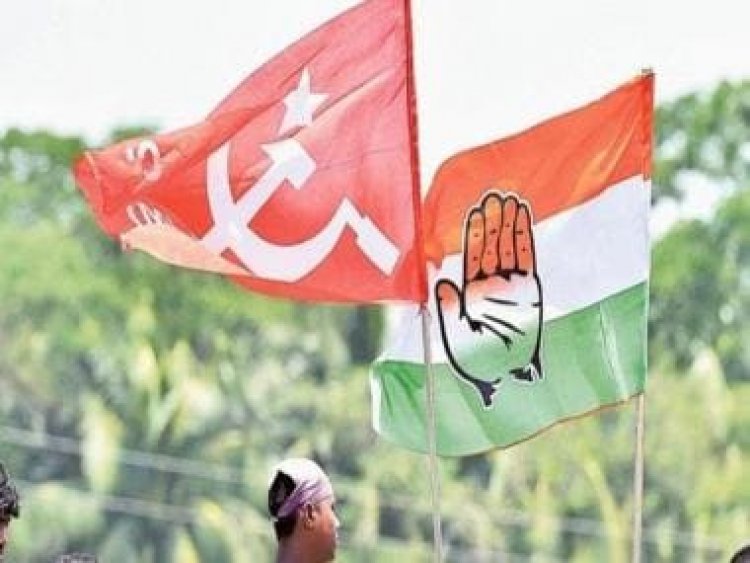No takers for CPM-Congress alliance in Tripura
No takers for CPM-Congress alliance in Tripura

While there is an ongoing quest for a united opposition at the national level, one such venture, the CPM-Congress alliance, stands rejected by the people of Tripura. As per our field study in all the 60 assembly constituencies, the alliance will not get seats in double digits. In fact, the alliance is going to lose even the prime opposition space to Tipra Motha, a regional party, thereby relegated to a distant third spot.
This sad state of the CPM-Congress alliance is primarily on account of the paradigm shift in the political culture of the state since 2018. Tripura is no longer a party society where the ruling party used to control every sphere of peoples’ lives and determined reward and punishment according to their political affiliations.
Across the state, an overwhelming section of Hindu Bengali voters who constitute around 70 percent of the electorates, justified their rejection of the opposition alliance on account of the negative past experiences. The memory of 25 years of the CPM rule is still perceived as politically sectarian, materially discriminatory and socially hostile to the non-party members.
The sentiment is best reflected in the oft-repeated remark, CPM Mukh Dekhe Dito, that the party favored and extended its political and material support only to its own. Also, the memory of forced participation in the michils (political processions) and compulsory chanda (party donation) during CPM’s reign still looms large in people’s mind.
Another factor adding to this gloomy state of the alliance happens to be the violent memories of the remaining Congress supporters who suffered colossally during the Left rule. We found multiple narratives of physical assault, political murder and social hostility among the existing Congress voters who feel completely alienated by their party. This section is least likely to transfer their votes to the alliance.
Secondly, the decadent state of the CPM-Congress alliance is also because of the shift in the nature of electoral consolidation. Unlike the old pattern of party-centric support base, when the CPM and the Congress used to have their respective vote banks among the Tribals and the Bengalis, now, the voters are overwhelmingly polarized along ethnic lines. Thus, barring Chakmas, Mogs and a section of Lucai (Mizos), most of the tribes are rallying behind Tipra Motha irrespective of their past political affiliations. This, in turn, affects the CPM significantly as it used to have a committed support base among the tribals, which now stands completely wiped out.
In this backdrop, a subtle but counter Hindu Bengali consolidation is also taking place. However, the CPM doesn’t emerge as their preferred choice on account of three reasons.
One, to a significant section of the Bengali electorates, the Left is still perceived as being pro-Tribal. In fact, the anxiety of the common Bengali voters of an imminent ethnic tension, given the past trends, psychologically drives them to opt for an alternative which is perceived as capable of mitigating the Faultline– a plank where CPM is losing out to the BJP.
Further, the alliance is also losing the war of perception as the most popular Left leader Manik Sarkar has opted out of the electoral contest, leaving the Jot without a chief ministerial face. This leaves only Muslim dominated assembly seats like Sonamura, Boxanagar, Kailashahar, Kadamtala-kurti among others where the alliance is likely to win.
Lastly, the opposition alliance in general and the CPM in particular is also losing out on account of the emergence of a new generation of voters who perceive CPM as a party of ageing leaders who they cannot relate to. Interestingly, our visit to the local CPM offices in various assembly constituencies revealed the ageing profile of the party leadership. Therein, these elderly leaders passionately talked about the problems of the youths without having a significant presence of the later.
In fact, they employed the material anxieties of the youths as a factor for the revival of their electoral fortune. This generation is highly aspirational and seeks a new package of cultural and material integration between the state and the Nation. Hence, the old plank of periphery vs the main land defining the political contour of the North-East is relegated to the background. This, in turn, goes against the parties who are seen relatively weaker in delivering on the aspirational and integrative quest of the new generation of voters. The CPM and Congress are losers on this count.
In this backdrop, the CPM-Congress alliance neither has positive chemistry, nor a language to relate to or enthuse any section of the voters. In this sad state of affairs, they are likely to be rendered invisible and irrelevant in the perception of the average voters.
A similar experiment of CPM-Congress alliance failed colossally in Bengal in 2016. In Tripura, they seem fated to witness a worse scenario. The alliance is staring at a humiliating defeat.
Thus, from voters vantage point, the alliance is losing on both, pragmatic as well as normative count. No wonder, a respondent named the alliance as Bamgress.
The authors are associated with PRACCIS, a Delhi based Research Institution.
Read all the Latest News, Trending News, Cricket News, Bollywood News,
India News and Entertainment News here. Follow us on Facebook, Twitter and Instagram.
What's Your Reaction?



























































